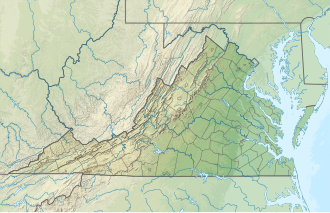This article needs additional citations for verification .(September 2011) |
| Snickers Gap | |
|---|---|
| Williams Gap | |
 Snickers Gap as seen from across the Loudoun Valley on Mount Gilead | |
| Elevation | 1,056 feet (322 m) [1] |
| Traversed by | |
| Location | Clarke County / Loudoun County, Virginia, United States |
| Range | Blue Ridge Mountains Appalachian Mountains |
| Coordinates | 39°6′56″N77°50′43″W / 39.11556°N 77.84528°W [2] |
Snickers Gap, originally William's Gap, is a wind gap in the Blue Ridge Mountain on the border of Loudoun County and Clarke County in Virginia. The gap is traversed by Virginia State Route 7. The Appalachian Trail also passes across the gap. Bear's Den and Raven Rocks are adjacent to the gap.
Contents
During the autumn bird migration the gap is a favored spot for birdwatchers to count and study the many raptors that follow the ridge on their way south.


